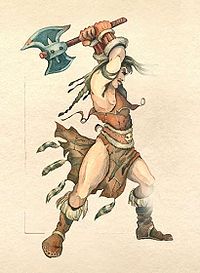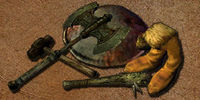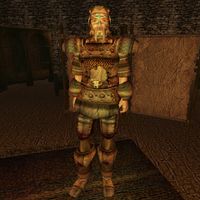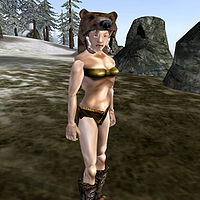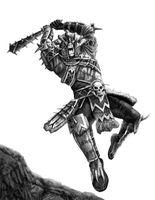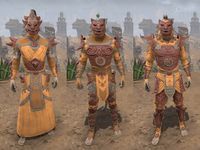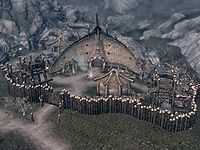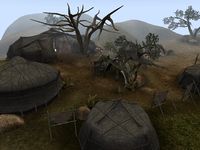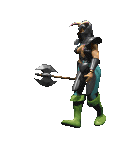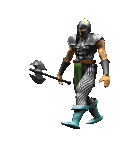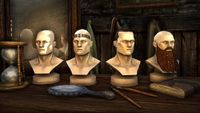Lore:Barbarians
|
Barbarians are the warrior subculture of society that lives out in the wilderness, i.e., plain nomads, mountain tribes, and sea reavers. Despite their blunt and aggressive attitudes, barbarians are battle-hardy and relish in finding glory.[1] They often hunt to sustain themselves and use their knowledge on wild animals, hunting, combat, and arms to sell their services to city-folk.[2]
Barbarians focus on speed and strength, which may be why they avoid heavy armor and prefer light or even medium armor.[3][4] They can also be medical experts as they have honed their ability to survive in the wilderness, they are also athletic, capable of swimming, climbing, and dodging. They may also be adept in the Giantish language.[5] The term is also used derogatorily when referring to someone brutish,[6] uncivilized, or even unintelligent.[7]
No other race is more synonymous with the derogatory term of "barbarian" as the Nords.[8][9] Although some would say that the Nords have come a long way from their original barbarian roots,[10] the other races of Tamriel still hold the same stigma. The Jarls of Skyrim have also garnered a reputation of being barbarians or uncivilized leaders. But to the surprise of Abdul-Mujib Ababneh, writer of Skyrim's Rule, each Jarls' court has its own formal structure.[11] Nordic barbarians prefer to wear fur armor.[12]
Equally as much so, the Reachmen also have the reputation of being barbarians.[13] Imperial and Nordic scholars have always denounced them as nothing more. But the Fourth Era Imperial scholar, Arrianus Arius believes these accounts were "victor's essays", skewed perspectives based on the ancient rivalry between the Reach and these races.[14] For a time, this perceptive slowly died out in the Interregnum, when the Longhouse Emperors reigned over the Imperial City and a relative, Caddach of the Blackdrake Clan was the Ard of Markarth. Caddach, with his experience and education from the south, hoped to turn the Markarth into a functional state and to dismiss the idea that the Reachfolk are not barbarians or unintelligent brutes.[15][16] This endeavor failed in the long run as Third Empire continues to look down on the Reachfolk as less than. The Battle of Old Hroldan is remembered as Tiber Septim's victory over the "barbarian natives".[14]
The Khajiit of Anequina have been characterized by their neighbors in Pellitine as militaristic barbarians.[17][18] While the southern Khajiit of Pellitine have adopted Breton and Imperial customs to re-model their society, the northern Khajiit of Anequina have always kept to their tribal, warrior traditions. One trains warriors to hone their martial discipline and battle tactics.[17]
Before their annexation into the Third Empire, many viewed the province of Hammerfell as a land of barbarians and cutthroats.[19] And while Tamriel's perception of Redguards has changed for the better, the province's wilderness hosts all sorts of barbarians. Across the Iliac Bay, which encompasses Hammerfell's north coast and most of western and southern High Rock, are barbarian strongholds.[20] The Orcs have long been considered barbarians since before written history[21] but while some use the term negatively, some people, including Orcs themselves spin it positively to reference their fighting prowess and capacity as brave and hardy warriors.[22]
Other races look down on the Bosmer as barbarians that believe in primitive superstitions, partake in shamanistic spirit worship and live in unheated communal huts.[23] The Wood Elves, especially those that live in the wilderness, worship the natural world (the Green) as a living and powerful entity.[24] They live by the Green Pact, a code of conduct that defines the relationship with their people and Y'ffre, the elven god of the forest.[25] Because of the Green Pact, the Wood Elves have never built their settlements, instead crafting them from the trees via the Greenspeakers' magic and eat mainly meat, whether it is animals or fallen enemies. The Wild Hunt is a phenomenon in which the Bosmer become feral shapeshifting monsters when needed and rampage across the province in a frenzy.[26]
Early Dunmer, back when they were originally Chimer lived in a barbarian society, as referred by the Tribunal Temple.[27] The Prophet, Veloth the Pilgrim yearned for a "pure way of life" for his followers, one marked with self-discipline and worship of the Good Daedra. This period (mid-late Merethic Era) under his guidance was known as the Golden Age, which shaped future generations.[28] This period declined by the late Merethic Era as the people started to settle and build tribal cultures that became the modern-day Great Houses and Ashlander tribes.[29]
As the Imperial Geographic Society explains it, early descriptions of the Dunmer people say they were divided in numerous, petty clans and tribes, half of which were at war with each other at any moment. Nordic sagas also explain that Chimer warriors would sometimes pledge themselves to Nordic chieftains if they happened to have a common enemy.[30] Nerevar was able to unite these barbarian tribes to fight against the Dwemer in the Battle of Red Mountain,[27] and found further assistance with the nomads that became the present-day Ashlander tribes.[31] For many years later, the Ashlander tribes were still viewed as barbarians[29][32] but with the fall of the Tribunal, came the Ashlanders' vindication as many people flocked to the wastes for a Wise Woman's counsel.[33]
The Tsaesci of Akavir look down on the Kamali as barbarians, especially for their loss in the Second Akaviri Invasion.[34] Similarily, the Greybeards looked down on the Blades, the elite order of warriors descended from the Tsaesci that fought Reman in the late First Era, as a cabal of "bloodthirsty" Akaviri barbarians.[35] The Riekr of Wrothgar are considered barbarians.[36]
Known Barbarians[edit]
- Alfhedil Elf-Hewer: A Nordic barbarian and a master Axe wielder from the late Third Era
- Igmund: The Jarl of Markarth in the Fourth Era
- Khargol gro-Boguk: An Orc barbarian and a master of the unarmored fighting style
- Tharsten Heart-Fang: The Nordic chieftain of the Skaal, who participated in the Great Hunt on Solstheim
- Ulfgar the Unending: An Atmoran barbarian who previously fought as one of the Five Hundred Companions
Barbarian tribes[edit]
- Berserkers: The "bare-sarks" or bare-chested, these Nords of Solstheim have been driven mad by the cold and too much mead
- Locvar: An ancient Altmer tribe that raided Tyrigel, the ancient Direnni home
Gallery[edit]
See Also[edit]
- For game-specific information, see the Arena, Daggerfall, Morrowind, Oblivion, and Skyrim articles.
Books[edit]
- ABCs for Barbarians — Picture book for barbarians
References[edit]
- ^ Barbarian class description in Morrowind
- ^ Barbarian "my trade" generic description in Morrowind
- ^ Barbarian class in Morrowind
- ^ Barbarian class in Oblivion
- ^ Barbarian class in Daggerfall
- ^ Arthenice Belloq Answers Your Questions — Arthenice Belloq
- ^ Crafting Motif 55: Dreadhorn Style — Gherig Bullblood of the Dreadhorn Clan [Notes by Rena Hammerhands]
- ^ Jhunal the Rune God
- ^ Loremaster's Archive - Dragons in the Second Era — Camilla Calsivius
- ^ Provinces of Tamriel
- ^ Skyrim's Rule — Abdul-Mujib Ababneh
- ^ Garothmuk gro-Muzgub's dialogue in Morrowind
- ^ A Life Barbaric and Brutal — Arthenice Belloq
- ^ a b The "Madmen" of the Reach — Arrianus Arius, Imperial Scholar
- ^ Report on the Despot of Markarth — Lady Nilene Devierin of Stormhaven
- ^ Scary Tales of the Deep Folk, Book 3 — Cassia Volcatia, Traveling Scribe
- ^ a b Anequina and Pellitine: An Introduction — Sulema, Initiate Scholar of the Pa'alatiin
- ^ Pocket Guide to the Empire, 3rd Edition: Sugar and Blood: the Cats of the South — Imperial Geographical Society, 3E 432
- ^ Pocket Guide to the Empire, 1st Edition: Hammerfell — Imperial Geographical Society, 2E 864
- ^ Barbarian Strongholds in Daggerfall
- ^ The Pig Children — Tyston Bane
- ^ Orc generic description in Morrowind
- ^ Bosmer generic dialogue in Morrowind
- ^ Green Pact Bosmer: Observations — Dinycthus Precis
- ^ The Green Pact and the Dominion
- ^ Pocket Guide to the Empire, 1st Edition: Aldmeri Dominion — Imperial Geographical Society, 2E 864
- ^ a b Lives of the Saints — Tribunal Temple
- ^ Veloth the Pilgrim — Cascius the Proud
- ^ a b Before the Ages of Man — Aicantar of Shimerene
- ^ Pocket Guide to the Empire, 1st Edition: Morrowind — Imperial Geographical Society, 2E 864
- ^ The War of the First Council — Agrippa Fundilius
- ^ Crafting Motif 48: Ashlander Style — Sannemmu Khamishi, Wise Woman of the Erabenimsun Tribe
- ^ The Reclamations — Thara of Rihad
- ^ Crafting Motif 53: Tsaesci Style — Kiasa-Veda, the Chronicler of Blades, Dir-Tonenaka
- ^ Arngeir's dialogue in Skyrim
- ^ Naryu's Journal/Wrothgar — Naryu Virian
